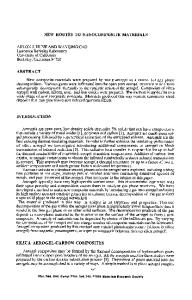Polymer-Clay Nanocomposite Materials: Solution and Bulk Properties
- PDF / 626,507 Bytes
- 6 Pages / 612 x 792 pts (letter) Page_size
- 70 Downloads / 339 Views
Polymer-Clay Nanocomposite Materials: Solution and Bulk Properties GUDRUN SCHMIDT*, ALAN I. NAKATANI, PAUL D. BUTLER, VINCENT FERREIRO, ALAMGIR KARIM, CHARLES C. HAN Polymers Division and Center for Neutron Research National Institute of Standards and Technology, Gaithersburg, Maryland 20899 ABSTRACT The influence of shear on viscoelastic polymer-clay solutions was investigated by means of small-angle neutron scattering (SANS) under shear. SANS measured the shearinduced orientation of polymer and platelets. With increasing shear rate an anisotropic scattering pattern developed. At higher shear rates, the scattering anisotropy increases due to the increased orientation of the clay platelets in the shear field. Cessation of shear leads to fast recovery demonstrating the system to be highly elastic. As a result of drying, these solutions produce translucent nanocomposite films with a microporous membrane character. Depending on the preparation and degree of polymer-clay film dispersion, it is possible to modify the morphology and elastic properties of nanocomposite materials. Atomic Force Microscopy (AFM) reveals the network character and the development of morphology as a function of polymer concentration. Preliminary SANS experiments on the films will be correlated to morphologies obtained from AFM. INTRODUCTION The objective of this work is to investigate the influence of shear on the structure development of highly viscoelastic, aqueous polymer-clay solutions. Here, we use SANS to study the shear orientation. Many models have been proposed for such solutions [1, 2, 3], but little is definitively known about the mesoscopic properties or shear behavior[1, 3]. This information is important in the production of nanocomposite materials. Nanocomposite polymeric materials offer unique mechanical, electrical and thermal properties. Such property enhancements are induced not only by the physical presence of the filler, but also by the interaction of the polymer with the filler and the state of dispersion [4, 5, 6, 7, 8]. Most reinforcing agents, such as fibers and fillers, are large and scatter light, thus reducing light transmittance. In our studies efficient particle dispersion combined with good interfacial adhesion is achieved in aqueous polymer clay solutions. This property is maintained in the bulk material, which is the main reason for transparency. From a practical viewpoint, this allows the exciting possibility of developing strong yet transparent films, coatings and membranes from the solution. MATERIALS In the following, we study a solution of the synthetic hectorite type clay, Laponite LRD (Laporte Industries Ltd.) [9], and poly(ethylene-oxide) (PEO) (Mw = 106 g/mol) [9, 10]. The results reported are for a highly viscoelastic solution containing a mass fraction of 3 % LRD and 2 % PEO (LRD2) at ambient temperature. The clay particles produce KK5.10.1
transparent dispersions of disk shaped particles ≈ 300 Å in diameter and ≈ 10 Å thick [11, 12]. The pH and ionic strength of the solutions were controlled by the a
Data Loading...











